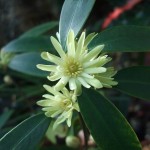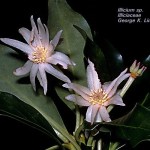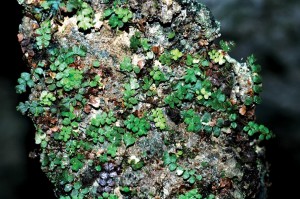 Visitors to Missouri Botanical Garden these days are greeted by an enormous yellow dragon lantern that stretches down the entrance to Ridgeway Visitor Center. It is easy to deduce that this creature is part of the upcoming Lantern Festival to be launched Memorial Day weekend.
Visitors to Missouri Botanical Garden these days are greeted by an enormous yellow dragon lantern that stretches down the entrance to Ridgeway Visitor Center. It is easy to deduce that this creature is part of the upcoming Lantern Festival to be launched Memorial Day weekend.
Thoughtful and/or frequent visitors will remember that this year’s orchid show had a Chinese theme, and that the Brookings Interpretive Center features an interactive exhibit on Chinese culture. Why the emphasis on China?
The Garden’s year of China is celebrating the imminent completion of a monumental scholarly achievement–the 45-volume Flora of China. This detailed description of each of the approximately 31,500 vascular plants that grow wild in China has great botanical value.
China is extremely rich in diversity of its flora; in an area approximately the size of the United States, it has 1.5 times the number of species of the US and Canada combined. Furthermore, just about half of these species are endemic to China, meaning they grow nowhere else in the world. About 5000 of these species are used in traditional Chinese medicine. The information in these volumes will be used for conservation of biodiversity, investigation of new sources for food and medicine, and understanding of evolution.
History of the Flora of China
The Flora of China is perhaps equally important in a historical context. The story of its joint publication by the Missouri Botanical Garden and Science Press in Beijing mirrors the evolution of Chinese-American relations over the past 35 years. It also mirrors the world wide technological revolution. Today, each volume published is freely available and searchable online. Thirty-five years ago, the internet was still in the experimental stage.

Photo by Kristi Foster, Missouri Botanical Garden
The death of Mao Zedong in 1976 marked the end of the Cultural Revolution. In 1977, the American committee on Scholarly Relations with the People’s Republic of China wrote Peter Raven, then Director of the Missouri Botanical Garden and president of the Botanical Society of America. The letter suggested that now might be the time to “get something started with China.”
Raven wrote the head of the Botanical Society of China, who had studied at the University of Illinois. They decided to exchange visits, as there had been little contact between the botanists of the two countries. Raven raised the money to first send a group of American scientists to China in 1978, and then bring a Chinese group here in 1979 to tour botanical institutions across the country.
At the end of the Chinese delegation’s visit, Raven and a former postdoctoral fellow, William Tai, organized a meeting at Berkeley, CA. (Tai, now deceased, became the co-director on the non-Chinese side of the Flora of China.) The result of the meeting was a suggestion to publish an English-language version of the Flora Reipublicae Popularis Sinicae, produced by Chinese scholars in the Chinese language between 1959 and 2004. That work consisted of 80 volumes in 126 parts.
There were several reasons for this goal:
- Formerly, Chinese scientists had had little access to the botanical literature.
- They had had no access to herbarium specimens outside of China.
- They had no access to “type specimens” — the herbarium specimens that define the meaning of a particular plant name. Many of these “type specimens” had been collected in China by western botanists in the 18th and 19th centuries.
A direct translation was out of the question. “Did I mention,” asked Raven, “that Chinese becomes 50% longer when translated to English?”
Raven came up with a plan, put into effect a full 10 years after that first American delegation visited China. There would be 25 volumes of text, containing short descriptions, names, synonyms, names given in Pinyin (transliteration of Chinese), uses and distribution. No illustrations were included because they had already been published.
As the project continued, however, and the revision became more scientifically up-to-date, separate volumes of illustrations to accompany the text became necessary. When the last volume is published the complete Flora will consist of 45 volumes: 22 books of text, 22 books of illustrations, and an introductory volume.

The Flora of China is a truly a collaboration. Every account—every family, genus, species—is co-authored by at least one Chinese and one non-Chinese botanist. The Chinese botanist writes the first draft in English. After the draft has been edited, it is sent to the non-Chinese author for revision. The draft is then sent back to the Chinese author and other reviewers. In case of scientific disagreement, the Chinese author’s version is used, but the other view is also explained in the text.
This framework has led to hundreds of new international collaborations, partnerships, and friendships. Because of the framework, and the occasional judicious mediation by Nicholas Turland, project co-director, or Raven, the Flora is considered a landmark in Chinese-American scholarly cooperation. Today, says Raven, botanists are able to do fieldwork throughout China.
What is a Flora and why is it important?
A flora organizes by relationship every single plant species that grows uncultivated in a region. Its descriptions of each plant include unambiguous nomenclature, a key to identification, geographical distribution, ecological data, and references to external information, according to Nicholas Turland.
And, says Turland, “a flora is out of date as soon as it is sent to the printer.” The discovery of new species does not stop with the publication of a flora volume. For example, when the volume on orchids was published in September, 2009, 1388 species were described. By September 2011, 50 completely new species had been identified. New species are added to the online flora.

Photo courtesy Alternativeeden

Photo by George K. Linney
The precise description of each species in a genus becomes extremely important when considering a specific use for a plant. Turland gives the example of the plant that until very recently was the only source of starting material for the antiviral Tamiflu. Illicium verum (also known as star anise) is endemic to South China and perhaps also Vietnam. It is just one of 27 species of the genus Illicium that grow in China. Other species, such as the near look-alike Illcium simonsii are described in the Flora as “very poisonous.” So knowing your species can be the difference between surviving bird flu and dying from the medicine you take to cure it.
A complete flora—and especially one that can be added to online—is a necessary tool for preserving biodiversity. According to Raven and Turland, you must know what you have in order to devise strategies of conservation and sustainable use. Rare and endangered species require special protections.
Libing Zhang has double responsibilities for the Flora of China. He has been the editor of the illustration volumes since 2006, and is also editor and coordinator of the volume on ferns, the very last of the text volumes, due for publication at the end of this year. In addition, he is the Chinese author of about 300 species in the fern book.

Photo by Libing Zhang
Some of the ferns that Zhang describes illustrate just how rare and how ecologically fragile certain species can be. In his fieldwork exploring the caves and sinkholes of the karst landscape in southwest China’s Guizhou province, he has found species with as few as 25 surviving plants. Polystichum minutissimum is an example of an endangered species. This smallest fern of the genus Polystichum grows on dripping stalactites near the mouth of a single cave in southern China. It requires a constant low temperature, low light, and much moisture on the limestone substrate. It is in danger from global warming, because the temperature has risen in the cave. These ferns cannot grow in the cooler temperatures deep in the cave because there is no light. (As it is, their metabolism is so low that it takes several years for a plant to produce spores.) Global warming has also changed the composition of the plants growing around the cave, resulting in less available water for the stalactites. This species could soon disappear.
Why the emphasis on botanical biodiversity? Raven points out that we all ultimately depend upon plants for food, medicine, and most other necessities of life. Yet of the 366,000 species of known plants, humans get 90% of their food from only 103. Many more are edible. In fact, 60% of food calories come from just corn, wheat, and rice. Soybeans and rice are both native to China. Rice is the diet mainstay of billions. If in the future rice needs to grow in the salty coastal marshes of India, botanists will need to know what other plants grow in salt marshes. They will need to understand the genetics, to see what traits can be transferred or bred to sustain rice growing in new conditions.
Flora of China Trivia from Nick Turland
- 9 million words of text
- 10,500 pages of text
- 19,000 black and white illustrations
- 31, 500 species
- 3,400 genera
- 330 families
- 8.6% of the world flora, summing about 366,000 species of vascular plants
- 16,000 species (4.3 % of the world flora), for which China is the only home
(numbers are rounded)
A stroll through the Garden shows us how important the flora of China is to horticulture. Camellias, peonies, forsythia, daylilies—all native to China. Every plant in the Nanjing Chinese Garden is a Chinese native, and a number of them have been collected there. Actually, 42 species of plants in the Garden have been collected in China. And of all the plants on display, hundreds of species are native to China; in the Garden database, 37 Chinese species are listed in the “A’s” alone. In this year of China, some plants like yellow groove bamboo, princess tree, and paper bush will acquire special signage.
Flora of China to be part of online World Flora
Earlier this year Missouri Botanical Garden, the Royal Botanic Gardens, Kew, the Royal Botanic Garden Edinburgh, and The New York Botanical Garden initiated the formation of a worldwide consortium to create an online World Flora. It will build upon The Plant List (the online global checklist of all the world’s plants) and upon works such as the Flora of China.
Commented Peter Wyse Jackson, Missouri Botanical Garden president, “The work of the Garden over the past 25 years on the Flora of China has been a monumental effort which is now close to completion. As we move on to playing a leading role in developing a World Flora Online by 2020, all of the wonderful work completed for China will become an essential part and foundation for that endeavor too.”
This article was originally published in the St. Louis Beacon.
